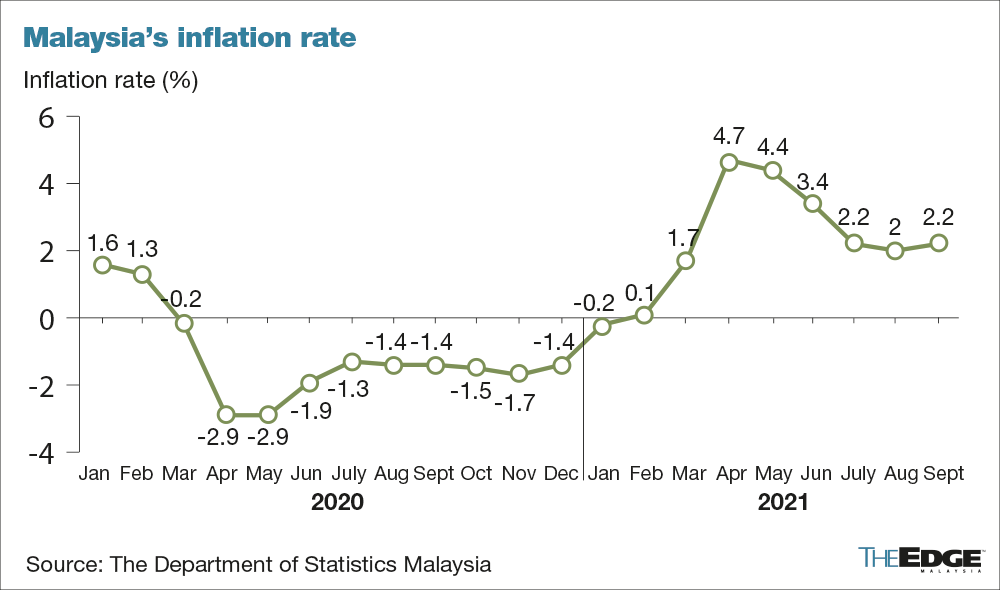
The OPR at 1.75% is the lowest on record, according to BNM data, which dates back to 2004 on the Central Bank’s website. The OPR has been on hold for eight straight meetings since September 2020.
KUALA LUMPUR (Nov 3): Bank Negara Malaysia's (BNM) Monetary Policy Committee's (MPC) decision to keep the overnight policy rate (OPR) at 1.75% on Wednesday came as no surprise, according to economists, as the country’s economic situation has improved and the number of Covid-19 cases nationwide has stabilised.
The OPR at 1.75% is the lowest on record, according to BNM data, which dates back to 2004 on the Central Bank’s website. The OPR has been on hold for eight straight meetings since September 2020.
According to UOB Malaysia senior economists Julia Goh and Loke Siew Ting, BNM sounded more optimistic on the growth outlook particularly as private spending resumes and with further policy support.
However, the duo said hawkish rate-bets have been reverberating in markets following the strong growth projections and record expansionary Budget 2022 tabled last Friday (Oct 29).
“We think main causes that could trigger BNM to consider earlier rate hikes include more robust and stable domestic growth in coming months and signs of wider pass-through of higher costs to consumers as the economy recovers.
“Given the nascent recovery, potential risk of virus resurgence, existing spare capacity, subdued property inflation, and ongoing subsidies to cap domestic fuel prices, we continue to expect BNM to stand pat on OPR until mid-2022. Thereafter, we pencil in a 25 basis point rate hike to 2% in the third quarter of 2022,” they said in the research note.
On the other hand, TA Securities economist Farid Burhanuddin commented, “The timing of rate hike depends on growth performance and inflation (both core and headline). I believe the rate of 1.75% will be maintained at least till the middle of next year and move towards 2% by the end of 2022. I expect a more neutral or hawkish tone to be adopted in the next Central Bank statement."
Although BNM struck a cheerful tone in highlighting the recovery momentum due to global demand and domestic reopening, OCBC Bank economist Wellian Wiranto said the Central Bank’s statement left a cautious impression.
“Still, to us, the words of caution are not there to pave the way for any rate cut. Instead, they are meant to ward off any sense that BNM will be in a hurry to hike [the] rate soon, particularly when coupled with its emphasis that inflation pressure will remain moderate.
“Set against the backdrop of how major Central Banks are starting to lean on tightening, BNM is keen to note that it will not be compelled to follow suit just yet,” he said in a note.
According to BNM, headline inflation is likely to average within the projected range of between 2% and 3% for 2021, having averaged 2.3% year to date. The Central Bank also noted the headline inflation is projected to remain moderate next year.
With the rate of inflation hovering within BNM’s forecast, MIDF Research emphasised that there is less pressure for BNM to quickly shift towards policy tightening.
“Despite keeping the OPR unchanged at 1.75% throughout this year, we foresee that BNM will consider normalizing its benchmark interest rate next year. At this point, we expect the policy normalisation will likely be carried out in the later half of 2022.
“However, the decision will be subject to the stability of economic growth, the pace of price increases and further improvement in macroeconomic conditions, particularly a continued recovery in the labour market and growing domestic demand.
“From a medium-term perspective, the policy rate normalisation is needed to avert risks that could destabilize the future economic outlook such as persistently high inflation and a further rise in household indebtedness,” the research house added.

